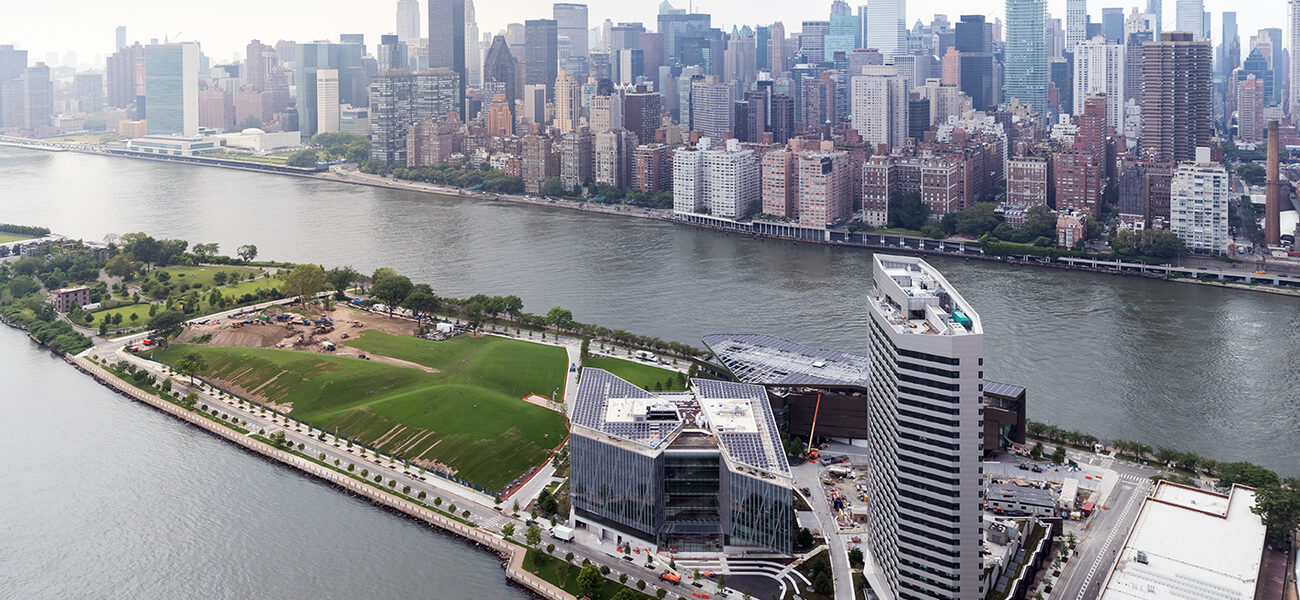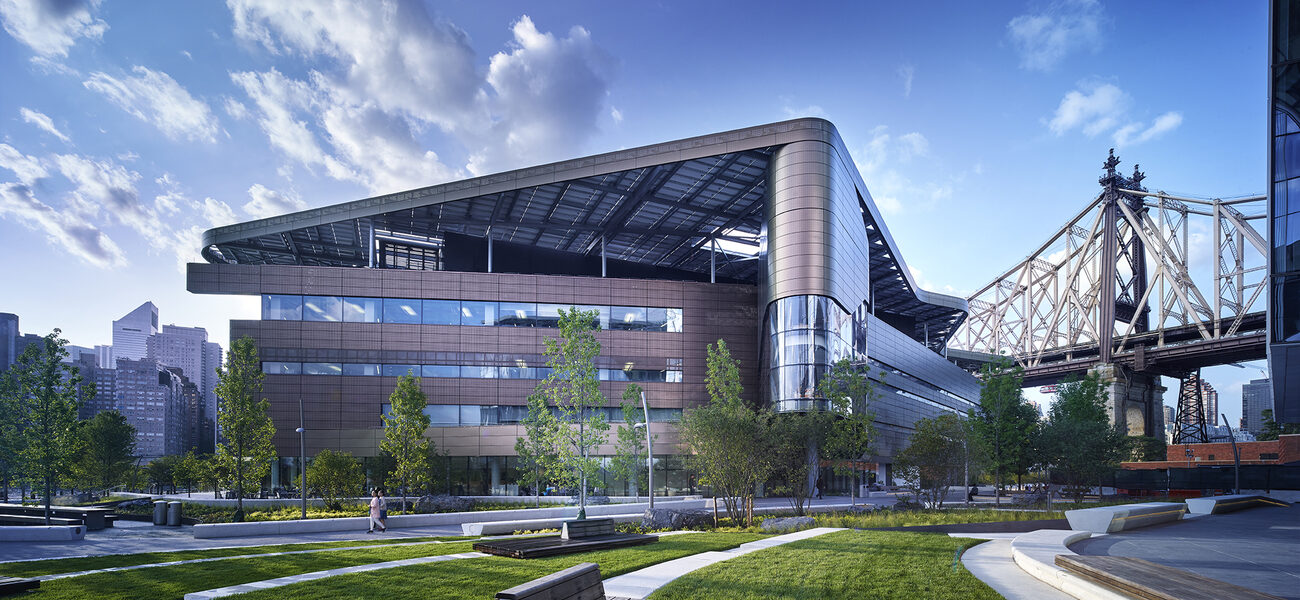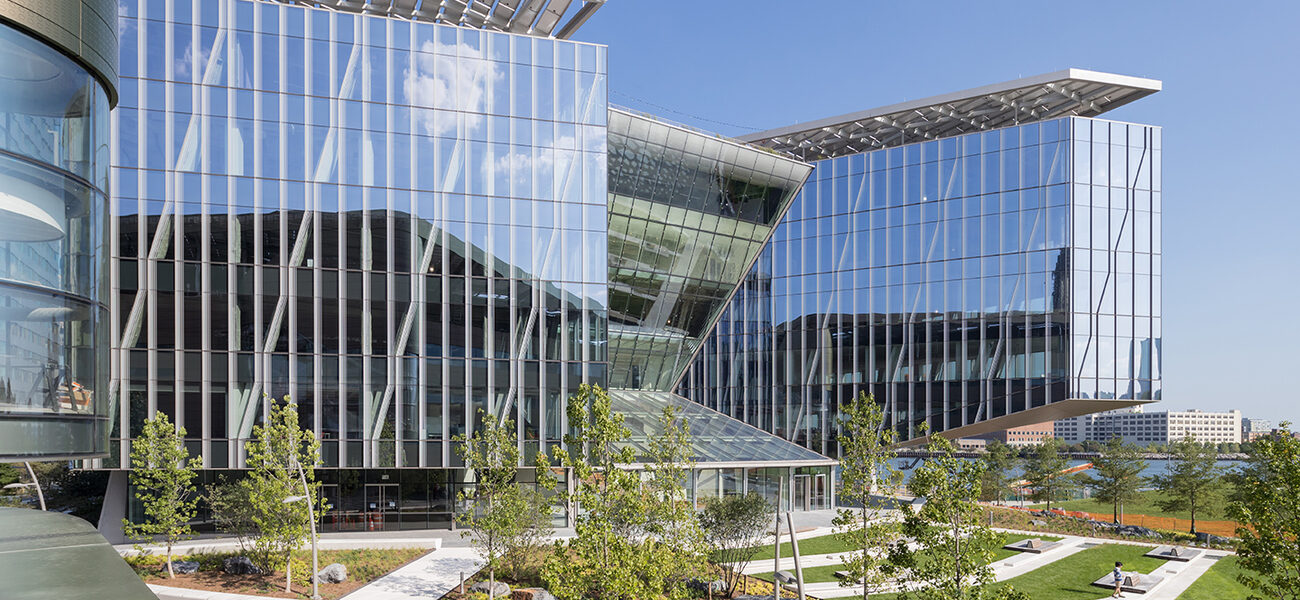The visually stunning, environmentally sustainable Cornell Tech graduate school opened this September on New York’s Roosevelt Island—a 12-acre stretch of land in the middle of the East River between Manhattan and Queens—creating what is intended to be a leading hub for technology education and business innovation in the center of the city. The new school was developed in response to a competition announced in 2010 by former mayor Michael Bloomberg to develop an applied-sciences and technology campus that could diversify the city’s economy beyond its traditional finance, advertising, and media sectors. Ideally, this new institution will transform NYC into the Silicon Valley of the east.
Ithaca-based Cornell University joined forces with Haifa-based Technion-Israel Institute of Technology to beat out more than a dozen entrants to partner with the city—which donated the land and $100 million in funding—to develop the campus site with extremely ambitious environmental and programmatic goals.
“Implementing cutting-edge new technologies like passive house and net-zero energy standards at such a large urban scale was extremely challenging,” says Andrew Winters, senior director of capital projects at Cornell Tech. “Especially considering the tight timeframes we had for completion. But extensive collaboration with city and state agencies, along with the local community, allowed us to move forward very quickly.”
Construction of phase one—which consists of three buildings, each designed by a different architect—began in 2015 and was completed in time for the start of fall classes in September 2017. From 2012 until then, Cornell Tech was housed inside Google’s Manhattan headquarters, where it already has produced a series of successful new startups.
Cornell Tech’s three initial buildings include the four-story Bloomberg Center, one of the largest net-zero academic buildings in the country; the Bridge, a six-story co-location building where students will collaborate with established corporations and innovative startups; and the House, an ultra-sustainable 26-story residential high-rise for graduate students, staff, and faculty that is proving to be a model for future residential construction in the city.
“We were very fortunate to work with an excellent team of developers and architects on this project who were not only up for the many challenges, but excited about creating some of the most sustainable and environmentally friendly buildings in the world,” says Winters.
Winning Partnerships
Cornell University’s established legacy of academic excellence combined with Technion’s progressive approach to globally applied research proved to be a perfect combination: The Cornell Tech campus is now home to the Jacobs Technion-Cornell Institute.
“The Jacobs Institute is a cornerstone of Cornell Tech,” says Ron Brachman, director of the Institute. “From our two master’s degree programs, to our groundbreaking faculty research, to the innovative companies spinning out of the Runway Startup program, our partnership will continue to keep New York City on the leading edge of technology.”
The Jacobs Institute—which offers master’s programs in Connective Media and Health Technology—operates as an independent entity integrated within the greater Cornell Tech curriculum. In a radical departure from traditional academia, faculty members do not have dedicated offices, and graduates of these programs receive master’s degrees from both Technion and Cornell.
“The basic ethos here is to create integrated spaces that are open and collaborative. Instead of the faculty being isolated in their offices, they can see people from a long distance away and consult with each other in meeting and huddle rooms. In our studio classes, students work together to develop real products. They work in collaborative ways rather than sitting at desks writing code,” says Brachman.
Bloomberg Center
The Bloomberg Center was the first academic building constructed on the campus. Designed by Morphosis Architects, the 160,000-sf facility is one of the largest net-zero academic buildings in the country. In addition to implementing a variety of site-specific energy reduction strategies, all of the facility’s power is generated on campus using a combination of solar, geothermal, and other technologies.
The building’s open-floor layout mimics modern tech offices, with a mix of private work areas and flexible meeting spaces designed to encourage collaboration. It also provides a heightened sense of transparency, with open sightlines throughout and glass façades on the ground floor.
“All of our buildings have flexible spaces where people can gather and collaborate—including meeting and huddle rooms, as well as casual public spaces with plenty of seating and tables,” says Winters,
The Bridge
The largest, most conceptually innovative building on the Cornell Tech campus is the Bridge, a six-story office-style building, designed by New York-based Weiss/Manfredi and developed by Forest City New York to drive a high level of practical collaboration between academic and commercial sectors.
“The Bridge is a first-of-its-kind building, where companies will have the opportunity to work alongside groundbreaking academic teams from Cornell Tech to solve new problems and develop new technologies,” says Winters.
While classrooms and teaching studios occupy 30 percent of the Bridge, the rest of the building provides office space with column-free floorplans and corner offices leasable to companies who see the benefit in collaborating with Cornell Tech students and faculty. Current tenants include technology and investment firm, Two Sigma, as well as Citigroup, and Ferrero International.
Two Sigma is hosting a “Collision Lab” in the building, where its R&D engineers will focus on solving difficult challenges away from the company’s main campus. Citigroup intends to work with Cornell Tech to develop emerging technologies such as blockchain, biometric authentication, IoT, and cyber security. Ferrero International—one of the world’s largest chocolate manufacturers—is leasing space for a new division that will explore digital innovations in the food industry.
The House
Designed by Handel Architects and developed by Hudson Companies and Related Companies, the House is the largest residential passive house high-rise in the world.
“It’s not a requirement to live at the House, but many of our students and some of our faculty choose to live there. A big part of our mission is to encourage collaboration, and we believe that works best when people have opportunities to work together outside the structured academic environment. We also wanted the campus to have a residential component so that it has a vibrant community life 24/7,” says Winters.
Passive house design is an international building standard previously applied mostly to single-family residential homes. It drastically reduces energy consumption while creating a more comfortable living environment for occupants by utilizing features that regulate the building’s temperature without requiring active energy systems, such as central heating.
Key passive house features include triple-thick insulated walls, double pane glass windows with reflective coating, and insulated floors. The super-sealed exterior is made of large insulated prefabricated panels that will help the building save more than 880 tons of carbon dioxide per year. A heat exchanger typically pulls outside air into the structure and warms it with interior air using a fraction of the usual energy.
To achieve these standards for Cornell Tech’s 26-floor, 350-unit House, Handel Architects had to design heat-exchange systems that could work at the scale of a high-rise building, while Hudson Companies had to train contractors on how to build to the new specifications. New York City’s Department of Buildings also had to grant code variances to allow for the new techniques to be implemented.
Now that the model has been successfully proven for high-rise applications, the city is embracing the idea of passive house design on a broader scale—issuing RFPs for publicly-funded passive house projects and low-income housing.
Urban Integration
The city also mandated that 20 percent of the campus be dedicated to publicly accessible open space. Anchoring this open space is a large multi-use plaza that serves as an outdoor gathering space for events. The plaza connects to a quarter-mile central walkway with a series of social spaces and cafés linked by pedestrian pathways with river-to-river views of both Manhattan and Queens.
“We designed Cornell Tech to foster collaboration and interaction at every turn. There are no gates or walls. It’s an open campus. Anyone can walk right onto it, and that’s exactly what we want,” says Winters.
Designed by James Corner Field Operations, the open space areas also feature rain harvesting technology for irrigation, bio-filtration gardens that naturally treat storm water before it enters the river, and an underground geoexchange field that provides energy to the Bloomberg Center.
Cornell Tech will begin construction this fall on the Verizon Executive Education Center and the Graduate Roosevelt Island Hotel—both designed by Snøhetta—which will provide space for academic conferences, executive programs, and academic workshops. Both are expected to open in 2019.
When fully completed, the $2 billion, 12-acre campus will be home to more than 2,000 graduate students and hundreds of faculty and staff. According to city estimates, Cornell Tech is expected to generate up to 8,000 permanent jobs and foster hundreds of spin-off companies generating more than $23 billion in economic activity over the next 35 years.
By Johnathon Allen



